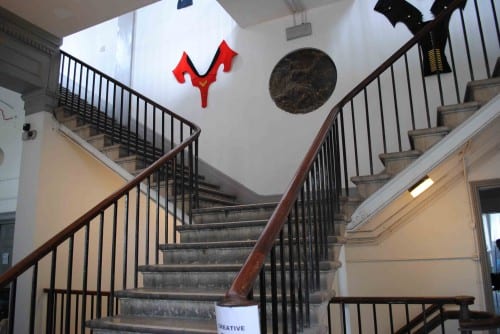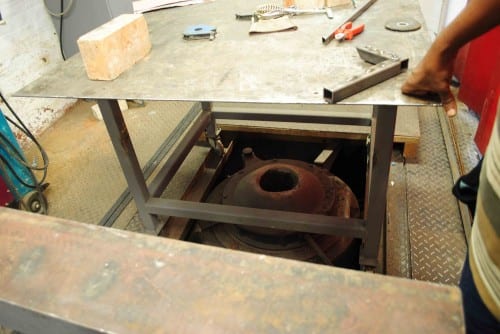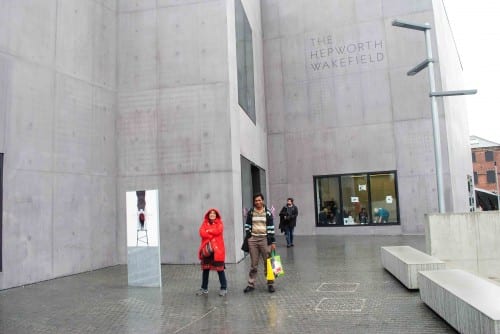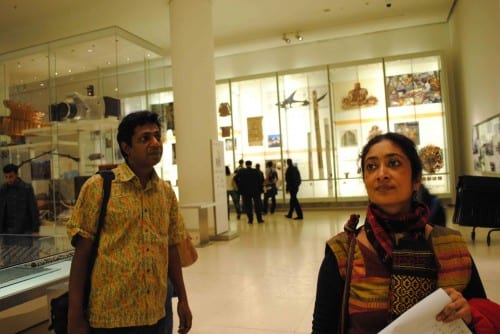Nasimul Khabir
By Susan Collins, on 25 June 2011

Nasimul Khabir (Duke) with John Bremner (l) and Giles Corby (r) in the Slade Workshop
The students are highly skilled in presenting themselves and their work systematically. Our students in Dhaka are much more dependent on description in the presentation of their work. In comparison Slade students are much more to the point. Cultural differences may be a reason behind this. The difference in the curricula of the institutions may be another reason for this. There is scope for greater research on this subject.
Notable was the conscious effort on the part of the teachers to attempt to remain objective in their judgment during the assessment. The completeness of the graduate show impressed me. Particularly the transformation of the studio spaces into exhibition spaces at the Slade is an experience from which we can learn. I noted how the graduate jury continued to discuss the work of the students at length and with care until they could reach a common decision.

Lala Rukh Selim and Nasimul Khabir (Duke) in front of the UCL portico while graduate sculpture student Julia Vogl’s MFA Degree work is being installed

The Slade Entrance during the Graduate Degree show 2011 (Installation on the stairs by David Birkin , MA Fine Art Media)
Experiencing the work of the undergraduate and graduate students I could see that not only students of Fine Art Media, students of Sculpture and Painting areas were also free to use any media in their work. Thus, though there are three subject areas at the Slade, the fact is that the entire program is primarily interdisciplinary. Susan Collins, Edward Allington, Tim Head, Dryden Goodwin and other teachers took us around the whole of Slade. All the Slade students share common laboratory and workshop facilities. The common workshop is under the supervision of responsible and skilled personnel. Students can work on carpentry, metal casting, welding, and other technology supervised by responsible staff. This makes the whole process efficient in terms of costs, space and management. This seemed to be something that would be very effective if followed by the Faculty of Fine Art in Dhaka. Besides this multi-purpose workshop the printmaking, bookbinding, sound, shooting and other studios seemed very advanced in terms of technology.
It was possible to go into some comparative discussions with members of Slade faculty. The Slade curriculum placed importance on individual needs which made it very successful in developing definite concepts or knowledge. On the other hand the Faculty of Fine Art at Dhaka aspired to a more generalized attitude through the contextual study of ideas in art history, aesthetics, philosophy and other fields. The Faculty at Dhaka also placed much greater stress on studies to develop skills. Besides visiting the Slade, experiencing contemporary and historical art at the British Museum, Victoria and Albert, National Gallery, Tate Modern, Serpentine, Barbara Hepworth Museum and other art spaces was yet another wonderful experience for me.Though this exchange program was conducted between the Slade and the Painting and Sculpture Departments of the Faculty of Fine Art, its activities affected the other departments of the Faculty. The younger teachers were particularly inspired by it. It indirectly influenced the continuing process of curriculum development. The influence is directly evident in the teaching process of the Sculpture Department. Halfway into this exchange the enthusiasm for the interdisciplinary was evidenced in the students of the Faculty. This can be considered an indirect outcome of the exchange. Students and faculty at either end are interested in continuing similar exchange programs. The credit for the success of this exchange program can be attributed to a large extent to the British Council and the University Grants Commission, Bangladesh.
Nasimul Khabir
 Close
Close



![foundry 1[1]](https://blogs.ucl.ac.uk/slade-dhaka-inspire/files/2015/01/foundry-11-500x334.jpg)




